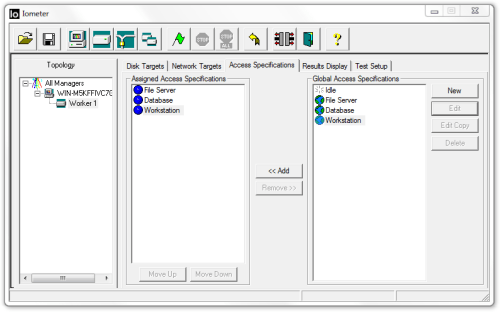- Qualcomm Launches Snapdragon 4 Gen 2 Mobile Platform
- AMD Launches Ryzen PRO 7000 Series Mobile & Desktop Platform
- Intel Launches Sleek Single-Slot Arc Pro A60 Workstation Graphics Card
- NVIDIA Announces Latest Ada Lovelace Additions: GeForce RTX 4060 Ti & RTX 4060
- Maxon Redshift With AMD Radeon GPU Rendering Support Now Available
Corsair Neutron GTX 240GB SSD Review

It’s the attack of the SandForce clones! Can any heroic atomic-powered SSD come to save us? Does Corsair’s Neutron have what it takes to rescue our PC in distress? Will the hordes of the positively-charged solid-state armies be neutralized in time? Tune in this week (or now) to find out!
Page 4 – Synthetic: Iometer
Originally developed by Intel – and since given to the open-source community – Iometer (pronounced “eyeawmeter”, like thermometer) is one of the best storage-testing applications available, for a couple of reasons. The first, and primary, is that it’s completely customizable, and if you have a specific workload you need to test a drive with, you can easily accomplish it here. Secondly, it bypasses the Windows disk subsystem entirely, meaning it bypasses the OS drivers and writes directly to the storage media. This has important implications, such as it means Windows 7 cannot correctly align Iometer to match the SSD or HDD sector alignment.
We have updated our test suite to the latest stable 1.10 rc1 build of Iometer, which was released in December, 2010. This version makes some changes to be aware of; specifically, it gives the option for three types of data sets used during testing. 2006 and earlier versions used a pseudo-random dataset for testing, while the 1.10 build will default to a “repeating bytes” test pattern. A full random test mode was also added. To avoid giving SandForce drives an unfair advantage (they rely on data compression to achieve their performance), we will stick to the pseudo-random test pattern for all of our testing.
We have configured Iometer for correct 4KB disk alignment using a single 8GB test file from within Windows, meaning they are acting as the host OS drive with no other drives in the system. We run individual random 4KB read and write tests at a queue depth of 3 and again at 32. Then we run the 128KB sequential read & write tests using a queue depth of 1. In addition, all drives are in a dirty state prior to testing – this means results will not be comparable to advertised manufacturer results. Our goal is to measure end-user performance under real-world conditions, and so our testing reflects typical SSD performance after it has been used for some length of time in a system. Each test pattern is run for 5 minutes to achieve an average result.
In addition, we have created three Iometer disk usage scenarios that should roughly approximate database, file server, and workstation usage patterns. These scenarios are run individually for 10 minutes each within an 8GB file on the drive, which is an unusually harsh scenario for any sort of SSD. Drives that are able to offer better sustained performance over time and those that favor certain file size accesses will do well here. All three tests are configured for a queue depth of 32 to show which drives are best capable of dealing with heavy workload scenarios.
“IOPS” is simply the measure of performance relative to a certain disk access size, specifically 4KB or 512 bytes, or any size desired. Typically with SSDs when speaking about IOPS it is referred to on the assumption of 4KB accesses. With this in mind, it is easy to convert between IOPS and MB/s. Iometer provides both types of results to us and for the sake of concise graphs, brevity, and easily understandable results, we have elected to use MB/s for the 4KB and 128KB tests. For reference: IOPS = (MBps Throughput / KB per IO) * 1024 and MBps = (IOPS * KB per IO) / 1024.





I was admittedly eager to see how the LM87800 controller held up in our array of Iometer tests, as Iometer has the distinction of being the best program for highlighting key strengths and weaknesses of any SSD controller. Let’s just say, the Neutron doesn’t disappoint.
In the read tests the Neutron GTX manages to top the chart with sequential reads of approximately 90MB/s over the next best in our graph. It also offers a random 4KB read performance at a QD of 3 that is 37% higher than even the Vector. However, when moving up to a queue depth of 32 it gives up its performance lead, showing that the drive is tuned mostly for lower QD loads typical of consumer desktop use.
When moving to write performance the Neutron places second in sequential writes, although it is edged back to third in the random write portions of the tests. As for the scenario results, it slots in the middle of our graphs with some favoring toward the File Server test.
Overall this is very good performance, and Corsair is clearly onto something here. While it doesn’t deliver a clean sweep in our Iometer testing, the Neutron GTX proves it offers extremely strong performance in sequential reads and writes, and respectable performance in the random portions of our tests. In other words, it doesn’t compromise any single facet of SSD performance in order to deliver at times some of the best results we have seen to date, proving it’s a well-balanced competitor to the best SSDs currently on the market. Not bad at all for a previously unknown SSD controller.
Support our efforts! With ad revenue at an all-time low for written websites, we're relying more than ever on reader support to help us continue putting so much effort into this type of content. You can support us by becoming a Patron, or by using our Amazon shopping affiliate links listed through our articles. Thanks for your support!





